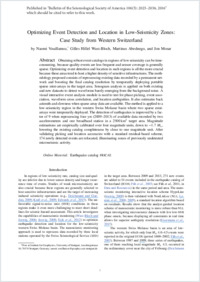Optimizing event detection and location in low‐seismicity zones: case study from western Switzerland
- Vouillamoz, Naomi Department of Geosciences, University of Fribourg, Switzerland - Institute for Geophysics, University of Stuttgart, Germany
- Wust-Bloch, Gilles Hillel Department of Geophysics and Planetary Sciences Tel Aviv University, Israel
- Abednego, Martinus Department of Geosciences, University of Fribourg, Switzerland
- Mosar, Jon Department of Geosciences, University of Fribourg, Switzerland
-
2016
Published in:
- Bulletin of the Seismological Society of America. - 2016, vol. 106, no. 5, p. 2023–2036
English
Obtaining robust event catalogs in regions of low seismicity can be time-consuming, because quality events are less frequent and sensor coverage is generally sparse. Optimizing event detection and location in such regions is all the more crucial because these areas tend to host a higher density of sensitive infrastructures. The meth- odology proposed consists of reprocessing existing data recorded by a permanent net-work and boosting the final catalog resolution by temporarily deploying portable sparse mini-arrays in the target area. Sonogram analysis is applied on both existing and new datasets to detect waveforms barely emerging from the background noise. A visual interactive event analysis module is used to test for phase picking, event asso- ciation, waveform cross correlation, and location ambiguities. It also estimates back azimuth and slowness when sparse array data are available. The method is applied to a low-seismicity region in the western Swiss Molasse basin where two sparse mini- arrays were temporarily deployed. The detection of earthquakes is improved by a fac- tor of 9 when reprocessing four yrs (2009–2013) of available data recorded by two accelerometers and one broadband station in a 2500 km2 target area. Magnitude estimations are empirically calibrated over four magnitude units, down to −1:7 ML, lowering the existing catalog completeness by close to one magnitude unit. After validating picking and location accuracies with a standard residual-based scheme, 174 newly detected events are relocated, illuminating zones of previously undetected microseismic activity.
- Faculty
- Faculté des sciences et de médecine
- Department
- Département de Géosciences
- Language
-
- English
- Classification
- Geology
- License
- License undefined
- Identifiers
-
- RERO DOC 277731
- DOI 10.1785/0120160029
- Persistent URL
- https://folia.unifr.ch/unifr/documents/305161
Statistics
Document views: 105
File downloads:
- mos_oed.pdf: 161
